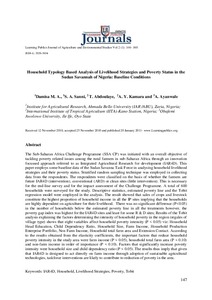| dc.contributor.author | Damisa, M.A. |
| dc.contributor.author | Sanni, S.A. |
| dc.contributor.author | Abdoulaye, Tahirou |
| dc.contributor.author | Kamara, A.Y. |
| dc.contributor.author | Ayanwale, A. |
| dc.date.accessioned | 2019-12-04T11:10:35Z |
| dc.date.available | 2019-12-04T11:10:35Z |
| dc.date.issued | 2011-01 |
| dc.identifier.citation | Damisa, M.A., Sanni, S.A., Abdoulaye, T., Kamara, A.Y. & Ayanwale, A. (2011). Household typology based analysis of livelihood strategies and poverty status in the Sudan savannah of Nigeria: Baseline conditions. Learning Publics Journal of Agriculture and Environmental Studies, 2(1), 146-160. |
| dc.identifier.issn | 2026-5654 |
| dc.identifier.uri | https://hdl.handle.net/20.500.12478/2199 |
| dc.description.abstract | The Sub-Saharan Africa Challenge Programme (SSA CP) was initiated with an overall objective of tackling poverty related issues among the rural farmers in sub-Saharan Africa through an innovation focussed approach referred to as Integrated Agricultural Research for development (IAR4D). This paper employs some baseline data of the Sudan Savanna Task Force in analysing household livelihood strategies and their poverty status. Stratified random sampling technique was employed in collecting data from the respondents. The respondents were classified on the basis of whether the farmers are future IAR4D (intervention), conventional (ARD) or clean sites (little intervention). This is necessary for the end-line survey and for the impact assessment of the Challenge Programme. A total of 600 households were surveyed for the study. Descriptive statistics, estimated poverty line and the Tobit regression model were employed in the analysis. The result showed that sales of crops and livestock constitute the highest proportion of household income in all the IP sites implying that the households are highly dependent on agriculture for their livelihood. There was no significant difference (P<0.05) in the number of households below the estimated poverty line in all the treatments however, the poverty gap index was highest for the IAR4D sites and least for some R & D sites; Results of the Tobit analysis explaining the factors determining the intensity of household poverty in the region (regales of village type) shows that eight variables affect household poverty intensity (P < 0.05) viz: Household Head Education, Child Dependency Ratio, Household Size, Farm Income, Household Production Enterprise Portfolio, Non Farm Income, Household total farm area and Extension Contact. According to the results obtained from the elasticity coefficients, the important factors that reduce household poverty intensity in the study area were farm income (P < 0.05), household total farm area (P < 0.10) and non-farm income in order of importance (P < 0.10). Factors that significantly increase poverty intensity were household size and child dependency ratio (P < 0.05). The results thus imply that given that IAR4D is designed to act directly on farm income through adoption of sustainable agricultural technologies, taskforce interventions are likely to contribute to reduction of poverty in the area. |
| dc.language.iso | en |
| dc.subject | Households |
| dc.subject | Livelihoods |
| dc.subject | Strategies |
| dc.subject | Poverty |
| dc.subject | Income Generation |
| dc.title | Household typology based analysis of livelihood strategies and poverty status in the Sudan Savannah of Nigeria: baseline conditions |
| dc.type | Journal Article |
| dc.description.version | Peer Review |
| cg.contributor.affiliation | Ahmadu Bello University |
| cg.contributor.affiliation | International Institute of Tropical Agriculture |
| cg.contributor.affiliation | Obafemi Awolowo University |
| cg.coverage.region | Africa |
| cg.coverage.region | West Africa |
| cg.coverage.country | Niger |
| cg.coverage.country | Nigeria |
| cg.authorship.types | CGIAR and developing country institute |
| cg.iitasubject | Biodiversity |
| cg.journal | Learning Publics Journal of Agriculture and Environmental Studies |
| cg.howpublished | Formally Published |
| cg.accessibilitystatus | Limited Access |
| local.dspaceid | 90930 |

